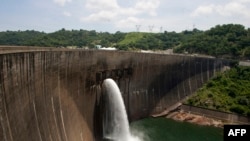China Energy's proposal, made to the state-owned Zimbabwe Power Company and a private consortium of the country's industrial power consumers, would see about 1.8 million solar panels installed at a cost of $987 million, the documents seen by Reuters show.
"The work scope of the project includes the design, procurement, construction and commissioning of a 1000MW AC floating solar farm and 330kV/33kV booster station," the document says. It would also include a transmission line from the booster station to a sub-station in Kariba.
China Energy has recently completed two floating solar projects in China's Shandong Province and Thailand, according to the documents.
Floating solar power stations are becoming an increasingly attractive option as developers seek to avoid using up large spaces and competing land-use interests.
The southern African country is currently generating less than half of its 1,700MW power demand, due to the underperformance of its ageing coal-fired plants and low water levels which impact generation from its 1,050MW hydropower plant at Kariba.
Zimbabwe last week started generating power from the first of its two new China-funded 300MWcoal-fired plants at Hwange, but plans to shift to renewable energy sources for its long-term electricity supply.
Last December, the government unveiled incentives meant to help bring 1,100MW solar projects on stream by 2025.




